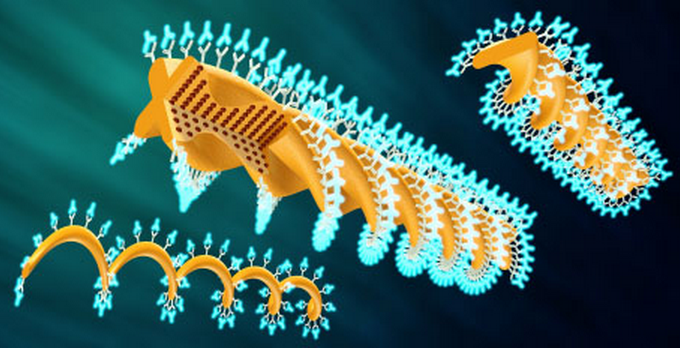 I didn’t really see this one coming, and if you did, I am duly impressed. With 3D printing technology, it’s not all about the external. Many medical breakthroughs due to 3D printing have been established with internal medical implants and devices. And we have also seen how 3D printing and robotics go hand in hand. But 3D printed micro-robots carrying medications or chemical sensor molecules to specific locations inside the body is a stunning idea — that seems all too much like common sense once you get the theory. Why not treat a problem directly at its source, no matter how difficult it may sound at first?
I didn’t really see this one coming, and if you did, I am duly impressed. With 3D printing technology, it’s not all about the external. Many medical breakthroughs due to 3D printing have been established with internal medical implants and devices. And we have also seen how 3D printing and robotics go hand in hand. But 3D printed micro-robots carrying medications or chemical sensor molecules to specific locations inside the body is a stunning idea — that seems all too much like common sense once you get the theory. Why not treat a problem directly at its source, no matter how difficult it may sound at first?
While simple headlines may cause their fabricated micro-actuators to sound as if they are just riding on the waves of recent technology, two professors at the Department of Mechanical and Process Engineering at ETH Zurich (Eidgenössische Technische Hochschule Zürich), one of the top universities in the world, have been working on this concept for years. Swimming micro-robots, working in the body as ‘cargo transporters,’ could be the key to changing the face of medicine in the future for:
- Minimally invasive surgery
- Targeted drug delivery
- Remote sensing
- Single cell manipulation
In two ETH Zurich groups led by Bradley Nelson, Professor of Robotics and Intelligent Systems, and Christofer Hierold, Professor of Micro and Nanosystems, researchers have come together with a formidable amount of knowledge most of us don’t even know exists — in making and applying magnetic micro-robots, as well as integrating new materials into microsystems.
“It is not just about swimming micro-robots,” says doctoral student Christian Peters from the group led by Professor Hierold. “The new technology can also be used when other micro-objects have to be manufactured with specific magnetic properties.”
With an additive manufacturing technique, the scientists are able to use a complex method to create the micro-robots, or micro-actuators, which are then coated with biomedical materials. The scientists believe they could increase functionality and deliver medication to targets inside the body.
The researchers do this by inserting magnetic nanoparticles into an epoxy resin and using a laser beam which moves repeatedly in a three-dimensional way, which through magnetizing, curing, and building allows them to produce helical structures 60 micrometers in length and 9 micrometers in diameter. Due to this design, the microscopic actuators swim consistently without veering off course, and can be digitally maneuvered.
“Previously, these elements wobbled as they moved forward, and they were less efficient because their magnetic properties were not ideal. We have now developed a material and a fabrication technique with which we can adjust the magnetic properties independent of the object’s geometry,” said Peters.
By coating these micro-robots, which are designed to operate like flagella, originally employing ‘corkscrew propulsion,’ the scientists were able to create a variation due to their microscopic 3D printing technique which gave them the flexibility to modify the shapes into spiral and twisted shapes, as well as double-twisted wires.
With these shapes, they are the same size, but have an exponentially larger surface, which means that they could carry more medication to the targeted internal source. “This makes the actuators more interesting for certain applications,” says Salvador Pané, research associate in the group led by Professor Nelson.
Scientists are literally able to get to the heart of a problem within the body with these magnetic, helix-shaped actuators — which along with 3D printing, may all turn out to be heroes of modern medicine.
Tell us what you think about this new medical concept that employs 3D printing in the 3D Printed Micro-Robots forum at 3DPB.com.
ETH Zürich is an engineering, science, technology, mathematics and management university in the city of Zürich, Switzerland.
[Source: Advanced Functional Materials]Subscribe to Our Email Newsletter
Stay up-to-date on all the latest news from the 3D printing industry and receive information and offers from third party vendors.
You May Also Like
3D Printing Unpeeled: Biofuel Waste to Filament & Sustainable Photopolymers
I can’t ever remember a day with so many potentially high impact news stories have come out. In one story, we all know that there are problems with the safety...
Finnair Hires AM Craft to 3D Print Plastic Parts for Aircraft Interiors
Riga-based AM Craft, a supplier specialized in 3D printing aviation components and certified under EASA Part 21G, announced a significant achievement today. The company will assist in upgrading Finnair’s A320...
3DPOD Episode 198: High Speed Sintering with Neil Hopkinson, VP of AM at Stratasys
Neil Hopkinson, a pioneering 3D printing researcher, played a pivotal role in developing a body of research that is widely utilized today. He also invented High Speed Sintering (HSS), also...
3D Printing Webinar and Event Roundup: May 12, 2024
Webinars and events are picking up in the AM industry this week! ASTM International continues its Professional Certificate Course and Stratasys continues its advanced in-person trainings, while 3D Systems is...



































